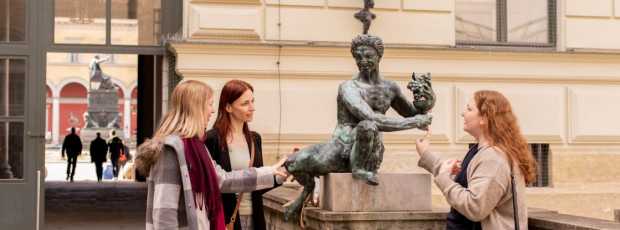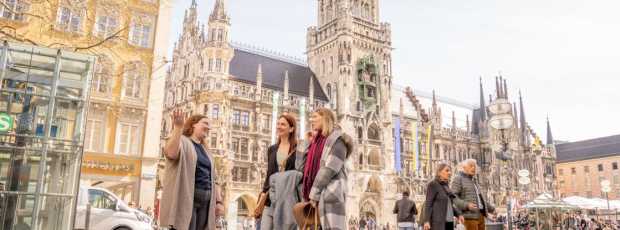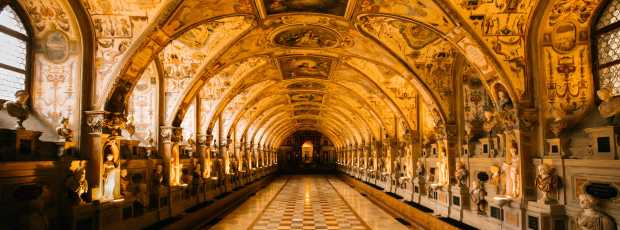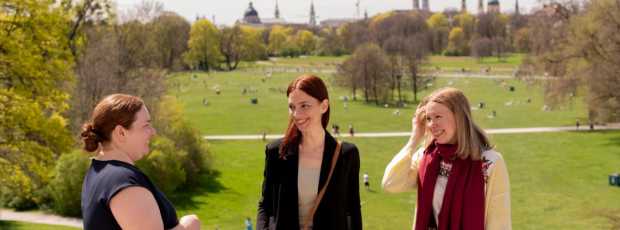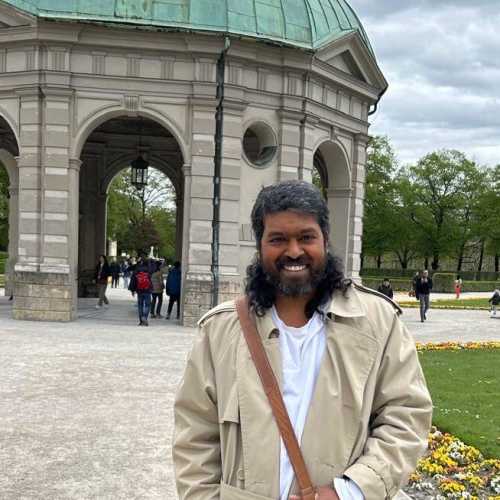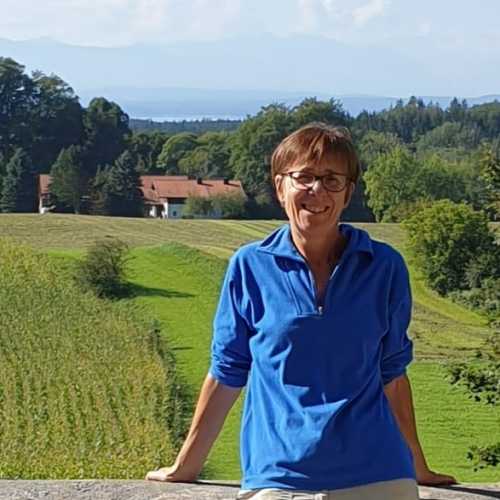Table Of Contents
- Munich, Minus the Lederhosen
- What's Happening When You Visit Germany This Time of the Year?
- The Real Oktoberfest Timing Explained
- October Weather: Not Bad, Actually
- Fall Food: From Wiesn Leftovers to Comfort Cravings
- Day Trips That Shine in Fall
- Munich's Seasonal Shift: First Sundays & Shoulder Season Life
- Winter Teasers: Why It's Worth Starting Early
- Final Thoughts: Is October a Good Time to Visit Munich?
Here's the thing about October in Munich: tourists have gone home, Oktoberfest is over, and we locals can breathe again. If you're wondering about things to do in Munich in October, you've stumbled onto something most visitors miss: the city itself.
This is when Munich sheds its lederhosen costume. The shoulder season brings cooler air, fewer crowds, and that particular German mood. Unlike spring weather in March and April with rain, or the summer heat of July and August, this month brings the full spectrum of what makes this country special. July feels like a different planet, hot, crowded, and louder in every way.
Munich, Minus the Lederhosen
If you're coming expecting the beer fest, you're three weeks late. But if you want to experience what this city feels like when it's not performing for tourists, you've timed it perfectly.
Beer gardens are quieter but still open. The Englischer Garten has crisp fall energy for long walks. We get our streets back, restaurants have tables available, and everything feels authentic.
This is shoulder season at its finest, when Germany reveals itself without pageantry. Unlike summer chaos or snow-covered winter sports season transforming the region, October lets you experience real-life rhythm. It's one of the best months to visit Germany, better than overcrowded summer or freezing January and February, when most of Europe shuts down.
What's Happening When You Visit Germany This Time of the Year?
More than you’d think, and more than most people realise when they first visit Germany.
Cultural Events in Full Swing
Cultural calendar kicks into high gear. Weekly concerts pop up in smaller venues, and events like the Long Night of Museums bring art lovers out after dark. While Viktualienmarkt doesn’t fully transform until mid-November, you’ll catch hints of the festive season sneaking in by late October. Menus shift to comfort foods as the city gears up for a full cultural stretch.
Outdoor festival season winds down, but indoor venues warm up. Staatsoper has the fall season in full swing, theaters launch productions, and galleries host openings that matter to locals, not tourists from other cities across Europe.
Local Festivals Worth Attending
You might stumble into a Kirchweih, a traditional harvest or beer festival, still happening in smaller towns this time of year. These aren't the massive festival crowds, but smaller celebrations where you can talk without shouting. Think of chatting with locals rather than performing in Munich for the world.
This is when locals reclaim their city, from riverside walks to intimate events tourists rarely discover.
Looking for a private city experience in Munich?
Explore the city with a local who plans a private day just for you; no groups, no scripts.
The Real Oktoberfest Timing Explained
Technically, yes. It ends the first Sunday in October, usually around October 3rd. The festival starts in mid-September, confusing everyone who doesn't live here.
Why the timing shift? Weather. September is more reliably warm and dry than October in Germany. By this point, you're looking at the aftermath, empty Theresienwiese, workers dismantling tents, odd tourists wondering where the beer went.
But you can still experience: some beer gardens keep a festive atmosphere into October. The Löwenbräu area sometimes has leftover pop-ups, and the traditional chain carousel usually runs another week.
Yes, you missed the fest, but the city still carries its mood, minus crowds and chaos. It’s one of those quirky details that make visiting Germany outside the obvious timelines surprisingly rewarding.
October Weather: Not Bad, Actually
The weather this month isn’t the pleasant weather of summer, but it's not the cold bite of winter either. Average temperatures hover around 12-15°C (54-59°F), with sunny days feeling warmer. The range of temperatures varies significantly; some days feel like late September warmth, others hint at November chill.
The key is layers. Mornings start cool, afternoons warm up, evenings drop back down. Pack a decent jacket, comfortable walking shoes, and you'll be fine for outdoor activities. Spring brings cherry blossoms, but the weather’s less predictable
Daylight shrinks noticeably, sunset around 6:30 PM by the end of the month, but long days of summer are replaced by dramatic golden hours. Light this time of year in Munich is spectacular, particularly in Englischer Garten and along the Isar River.
Rain happens, but it's brief. This isn't soggy, miserable cold. It's crisp, clear, and perfect for walking or light hiking in the surrounding region. Snow is rare but possible by month’s end, not the deep winter blanket that turns this part of Germany into a cross-country skiing destination, but just enough to remind you December is coming.
Layer up. Shoulder season has charm before winter sets in.
Fall Food: From Wiesn Leftovers to Comfort Cravings
Seasonal food in Munich is when eating makes sense. Those massive Wiesn pretzels disappear, replaced by comfort food locals want as temperatures drop.
Street Food and Market Treats
Street vendors switch to roasted chestnuts (Geröstete Maroni), smelling amazing on cool afternoons. Food stalls at markets like Viktualienmarkt offer seasonal specialties. Bakeries make Zwiebelkuchen, an onion tart that's autumn on a plate. Find Dampfnudeln (steamed dumplings), order immediately.
Beer Gardens and Local Restaurants
Beer gardens adapt menus. Heavier dishes appear: Schweinebraten, Sauerbraten, hearty soups complement cooler weather. Beer stays excellent, now you're drinking because it tastes good, not because you're overheating.
Skip touristy places near Marienplatz in the old town. Head to Glockenbach, where locals eat. Food is better, cheaper, and you won't perform in Munich for Instagram. This approach to experiencing the city gives an authentic taste of life in Germany.
Skip Oktoberfest pretzels. October menus taste like the start of winter comfort.
What if your day in Munich was planned by someone who knows it — and you?
City Unscripted matches you with a local host who creates a private experience based on your interests, not a set route.
Day Trips That Shine in Fall
This is an ideal time for day trips. Summer crowds thinned, autumn colors peak, and crisp air makes everything sharper. This is an ideal time to explore the wider region and visit other cities throughout Germany and Europe, or to simply slow down and explore with fewer expectations and more curiosity.
Castles and Medieval Towns
Neuschwanstein Castle is spectacular in the fall. Surrounding forest turns orange and gold, and you get better photos without packed tour groups. The range of colors in the Bavarian landscape this time of year rivals anything in the world.
Rothenburg ob der Tauber becomes atmospheric rather than Instagram-pretty. Medieval streets feel authentic without summer visitors, and autumn light makes half-timbered buildings properly gothic. Other picturesque towns throughout the country offer similar experiences, spending time exploring without fighting crowds.
Cities and River Cruises
Consider a Rhine River cruise or exploring major cities like Berlin. The capital city is appealing in the fall, when summer tourist surge ends, but temperatures haven't dropped to winter lows. Berlin's museums, galleries, and cultural events are in full swing during the fall months.
Bavarian Lakes Region
Bavarian Lakes region—Starnberger See, Ammersee, takes different character in fall. Less swimming, more walking and hiking along scenic trails, picture-perfect Alpine views without summer haze. The whole region transforms as temperatures drop and snow begins capping distant peaks.
This is an ideal time to explore Bavaria’s small towns without fighting crowds for photos.
Munich's Seasonal Shift: First Sundays & Shoulder Season Life
October means learning local rhythms tourists never notice.
Museum Deals and Olympic Park
First Sunday rule: many museums offer free admission first Sunday of each month. The first of the month usually falls on a weekend, perfect for museum hopping without fees.
Shoulder season brings advantages: hotel rates drop, restaurant reservations are possible, and attractions have breathing room. You can appreciate the Residenz or Pinakothek museums without being pushed through crowds. This is when you experience the city like a local.
The park becomes appealing in the fall. Summer sports crowds gone, facilities stay open. While the Olympic Tower is currently closed for renovations, the surrounding park still delivers wide-open paths, autumn colours, and views that stretch to the Alps on a clear day. For those interested in winter sports, the city starts preparing for the ski season, equipment shops reopen, and locals start planning winter escapes to regional snow destinations.
Markets and Local Culture
Markets shift into autumn mode. Viktualienmarkt vendors sell seasonal produce, pumpkins, late apples, and first winter vegetables. Menus shift from summer salads to hearty soups. Feels authentic when locals shop there instead of tourists taking photos.
The city’s rhythm changes during this season. Unlike the frantic summer pace catering to millions from across Europe and the world, October lets you experience the genuine pace of this German city. People linger in coffee shops, browse markets, and enjoy intimate concerts.
Visiting Munich now? Less checklist tourism, more genuine curiosity about how the city works.
Winter Teasers: Why It's Worth Starting Early
Munich’s Christmas period starts sneaking in around this time. Not full Christmas markets, those come in November and December, but preview setups and early holiday atmosphere, locals are used to preparing.
Small courtyards test mulled wine recipes. Craft vendors set up early stalls, catching locals doing advance Christmas shopping. City starts stringing lights that won't be turned on for weeks, but anticipation builds. Fascinating watching transformation begin, knowing by December entire city becomes one of the world's most famous Christmas destinations.
This early preview brings a festive mood without December crowds. You get a cozy atmosphere, warm drinks, and holiday spirit, but with milder shoulder-season weather and shoulder-season pricing. Unlike other major cities across Europe, Munich starts its transition gradually, giving a full range of experiences from autumn harvest festivals to early winter preparations.
Locals start planning Christmas market visits. We know which markets to hit when, where to find the best Glühwein, and how to navigate December crowds. This is reconnaissance season, the beginning of a serious Christmas market strategy. Many start planning tours through different neighborhoods, comparing festive Christmas markets that will dominate the city landscape from November through the New Year.
Tip
We match you with the right host, not just any guide.Want to experience the real Munich with someone who lives there?
A fully private experience, planned and led by a local host who tailors the day to you
Final Thoughts: Is October a Good Time to Visit Munich?
Is Germany a good place to visit in October? If you like life quieter, weirder, and more authentic than peak tourist season, absolutely yes.
Shoulder season perks are real: fewer crowds, better prices, and actual conversations with locals who aren't exhausted from summer tourism.
Is it the "best" time to visit? Depends on what you mean. Want guaranteed sunshine and everything open? Come in the summer. Want Christmas markets and winter magic with snow covering the region? Wait until December or January. But want Munich to be itself, complex, comfortable, genuinely interesting, October hits the sweet spot perfectly.
The range of Munich experiences available is remarkable. You can hike in the mountains, explore historical towns, attend concerts and cultural events, visit Germany's most famous castle, or just relax and people-watch in beer gardens. One of those rare months when the country shows full personality, not just tourist highlights, but everyday rhythm, making this part of Europe compelling.
Come now for a more authentic, less scripted visit to one of Germany's most fascinating cities. Planning to visit Germany beyond Munich? October weather makes it perfect for exploring the wider world of German culture and history.
For more seasonal insights, check out our guide to things to do in Munich in September to compare early fall experiences.
Ready to plan your perfect day in Munich?
Start your experienceWhat if your day in Munich was planned by someone who knows it — and you?
City Unscripted matches you with a local host who creates a private experience based on your interests, not a set route.
Want to experience the real Munich with someone who lives there?
A fully private experience, planned and led by a local host who tailors the day to you


